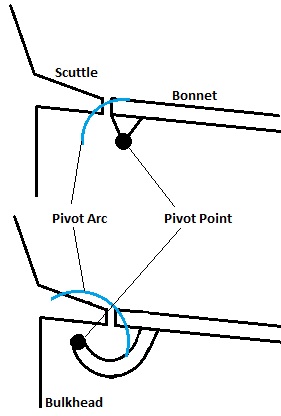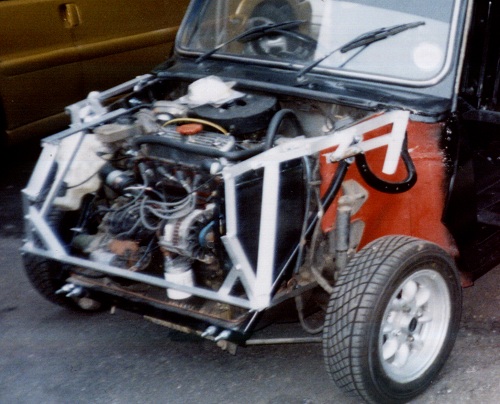
I'd always planned to fit a flip front, for two reasons - one it makes access to the engine a lot easier (many
skinned knucles working on it in the past) and two I had an idea for an unusual way of making the flip-front open,
and thought it would be quite neat.

My Idea was to allow it to open up from the rear, hinged under the scuttle panel (most of the ones I'd seen before opened up on hingies at the front, which gets in the way). To make this work the pivot needs to work such that the arc traced by the rear edge of the bonnet doesn't run through the scuttle as it opens. The diagram on the right is an explanation of this, in the upper example the pivot point is directly underneath the rear edge of the bonnet, and as the bonnet opens it will foul the scuttle panel. In the lower example the pivot point is much further rearwards, and the arc the rear of the bonnet follows clears the scuttle.
That is how the regular Mini bonnet hinges work, but they aren't up to the additional weight of a complete flip front (they seem flimsy enough with just the bonnet!), so I thought that the best way of doing this would be to use boot hinges from a saloon car, as they're designed to solve the same problem, and take a heavier load.
So I went and bought a pair of VW Jetta boot hinges from a scrappy, with the intention of mounting them high up via a bolt through the inner sill and an aluminium framework to attach to the fibreglass front, as shown below left without the flip-front fitted on to the framework.
 However, when I tried to fit it all up, I discovered a problem - it wasn't possible to mount the hinge onto the
inner wing far enough up and back to allow the front end to clear the scuttle on opening. As I was on to a deadline
and hadn't got time to find some more suitable hinges, I came up with the bodge you can see in the picture - what I
did was to add a horizontal piece bolted to the hinge, connected by two unequal length verticle bar setions to the
frame that the flip front mounts on. This allows the whole front to be pulled forwards before the front is raised,
which gives enough clearance that the bonnet doesn't foul the scuttle panel. Not the most elegant solution, but it
does work (although propping the front up is problematic!)
However, when I tried to fit it all up, I discovered a problem - it wasn't possible to mount the hinge onto the
inner wing far enough up and back to allow the front end to clear the scuttle on opening. As I was on to a deadline
and hadn't got time to find some more suitable hinges, I came up with the bodge you can see in the picture - what I
did was to add a horizontal piece bolted to the hinge, connected by two unequal length verticle bar setions to the
frame that the flip front mounts on. This allows the whole front to be pulled forwards before the front is raised,
which gives enough clearance that the bonnet doesn't foul the scuttle panel. Not the most elegant solution, but it
does work (although propping the front up is problematic!)
I hindsight I could have just mounted a horizontal bar directly to the inner wing, and then used two unequal length verticle bars to connect to the flip-front frame,(diagram right) which would have achieved the same result, with less parts (and is used by manufacturers for some bonnet and boot hinges!!!).
I've since found a better way of doing it, using BMW E39 saloon boot hinges, see here, which is what I'll be using in future! (and as has already been done by someone else on pistonheads)
With the frame now secured in place, I fastened the flip front to it using bonnet pins on the rear (for aesthetic reasons rather than any expectation to be removing it regularly) and M8 set screws on the front. The frame locks into position on the front using bonnet pins mounted on an aluminium angle frame that is bolted to the front subframe.


My Idea was to allow it to open up from the rear, hinged under the scuttle panel (most of the ones I'd seen before opened up on hingies at the front, which gets in the way). To make this work the pivot needs to work such that the arc traced by the rear edge of the bonnet doesn't run through the scuttle as it opens. The diagram on the right is an explanation of this, in the upper example the pivot point is directly underneath the rear edge of the bonnet, and as the bonnet opens it will foul the scuttle panel. In the lower example the pivot point is much further rearwards, and the arc the rear of the bonnet follows clears the scuttle.
That is how the regular Mini bonnet hinges work, but they aren't up to the additional weight of a complete flip front (they seem flimsy enough with just the bonnet!), so I thought that the best way of doing this would be to use boot hinges from a saloon car, as they're designed to solve the same problem, and take a heavier load.
So I went and bought a pair of VW Jetta boot hinges from a scrappy, with the intention of mounting them high up via a bolt through the inner sill and an aluminium framework to attach to the fibreglass front, as shown below left without the flip-front fitted on to the framework.
 However, when I tried to fit it all up, I discovered a problem - it wasn't possible to mount the hinge onto the
inner wing far enough up and back to allow the front end to clear the scuttle on opening. As I was on to a deadline
and hadn't got time to find some more suitable hinges, I came up with the bodge you can see in the picture - what I
did was to add a horizontal piece bolted to the hinge, connected by two unequal length verticle bar setions to the
frame that the flip front mounts on. This allows the whole front to be pulled forwards before the front is raised,
which gives enough clearance that the bonnet doesn't foul the scuttle panel. Not the most elegant solution, but it
does work (although propping the front up is problematic!)
However, when I tried to fit it all up, I discovered a problem - it wasn't possible to mount the hinge onto the
inner wing far enough up and back to allow the front end to clear the scuttle on opening. As I was on to a deadline
and hadn't got time to find some more suitable hinges, I came up with the bodge you can see in the picture - what I
did was to add a horizontal piece bolted to the hinge, connected by two unequal length verticle bar setions to the
frame that the flip front mounts on. This allows the whole front to be pulled forwards before the front is raised,
which gives enough clearance that the bonnet doesn't foul the scuttle panel. Not the most elegant solution, but it
does work (although propping the front up is problematic!)I hindsight I could have just mounted a horizontal bar directly to the inner wing, and then used two unequal length verticle bars to connect to the flip-front frame,(diagram right) which would have achieved the same result, with less parts (and is used by manufacturers for some bonnet and boot hinges!!!).
I've since found a better way of doing it, using BMW E39 saloon boot hinges, see here, which is what I'll be using in future! (and as has already been done by someone else on pistonheads)
With the frame now secured in place, I fastened the flip front to it using bonnet pins on the rear (for aesthetic reasons rather than any expectation to be removing it regularly) and M8 set screws on the front. The frame locks into position on the front using bonnet pins mounted on an aluminium angle frame that is bolted to the front subframe.
